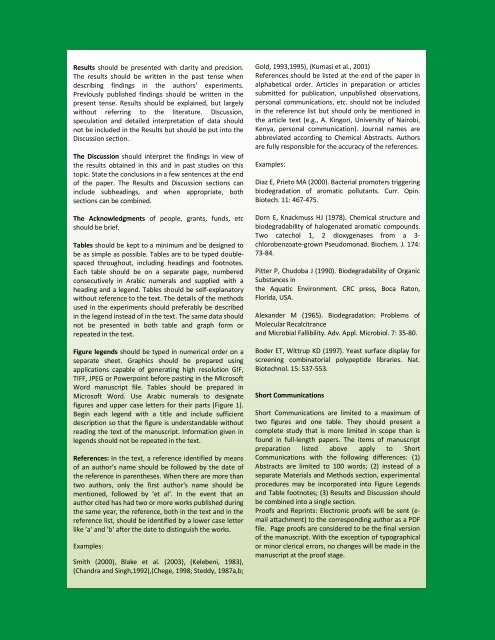(L.) C. Jeffrey from India using internal transcribed - Academic ...
(L.) C. Jeffrey from India using internal transcribed - Academic ...
(L.) C. Jeffrey from India using internal transcribed - Academic ...
You also want an ePaper? Increase the reach of your titles
YUMPU automatically turns print PDFs into web optimized ePapers that Google loves.
Results should be presented with clarity and precision.<br />
The results should be written in the past tense when<br />
describing findings in the authors' experiments.<br />
Previously published findings should be written in the<br />
present tense. Results should be explained, but largely<br />
without referring to the literature. Discussion,<br />
speculation and detailed interpretation of data should<br />
not be included in the Results but should be put into the<br />
Discussion section.<br />
The Discussion should interpret the findings in view of<br />
the results obtained in this and in past studies on this<br />
topic. State the conclusions in a few sentences at the end<br />
of the paper. The Results and Discussion sections can<br />
include subheadings, and when appropriate, both<br />
sections can be combined.<br />
The Acknowledgments of people, grants, funds, etc<br />
should be brief.<br />
Tables should be kept to a minimum and be designed to<br />
be as simple as possible. Tables are to be typed doublespaced<br />
throughout, including headings and footnotes.<br />
Each table should be on a separate page, numbered<br />
consecutively in Arabic numerals and supplied with a<br />
heading and a legend. Tables should be self-explanatory<br />
without reference to the text. The details of the methods<br />
used in the experiments should preferably be described<br />
in the legend instead of in the text. The same data should<br />
not be presented in both table and graph form or<br />
repeated in the text.<br />
Figure legends should be typed in numerical order on a<br />
separate sheet. Graphics should be prepared <strong>using</strong><br />
applications capable of generating high resolution GIF,<br />
TIFF, JPEG or Powerpoint before pasting in the Microsoft<br />
Word manuscript file. Tables should be prepared in<br />
Microsoft Word. Use Arabic numerals to designate<br />
figures and upper case letters for their parts (Figure 1).<br />
Begin each legend with a title and include sufficient<br />
description so that the figure is understandable without<br />
reading the text of the manuscript. Information given in<br />
legends should not be repeated in the text.<br />
References: In the text, a reference identified by means<br />
of an author‘s name should be followed by the date of<br />
the reference in parentheses. When there are more than<br />
two authors, only the first author‘s name should be<br />
mentioned, followed by ’et al‘. In the event that an<br />
author cited has had two or more works published during<br />
the same year, the reference, both in the text and in the<br />
reference list, should be identified by a lower case letter<br />
like ’a‘ and ’b‘ after the date to distinguish the works.<br />
Examples:<br />
Smith (2000), Blake et al. (2003), (Kelebeni, 1983),<br />
(Chandra and Singh,1992),(Chege, 1998; Steddy, 1987a,b;<br />
Gold, 1993,1995), (Kumasi et al., 2001)<br />
References should be listed at the end of the paper in<br />
alphabetical order. Articles in preparation or articles<br />
submitted for publication, unpublished observations,<br />
personal communications, etc. should not be included<br />
in the reference list but should only be mentioned in<br />
the article text (e.g., A. Kingori, University of Nairobi,<br />
Kenya, personal communication). Journal names are<br />
abbreviated according to Chemical Abstracts. Authors<br />
are fully responsible for the accuracy of the references.<br />
Examples:<br />
Diaz E, Prieto MA (2000). Bacterial promoters triggering<br />
biodegradation of aromatic pollutants. Curr. Opin.<br />
Biotech. 11: 467-475.<br />
Dorn E, Knackmuss HJ (1978). Chemical structure and<br />
biodegradability of halogenated aromatic compounds.<br />
Two catechol 1, 2 dioxygenases <strong>from</strong> a 3chlorobenzoate-grown<br />
Pseudomonad. Biochem. J. 174:<br />
73-84.<br />
Pitter P, Chudoba J (1990). Biodegradability of Organic<br />
Substances in<br />
the Aquatic Environment. CRC press, Boca Raton,<br />
Florida, USA.<br />
Alexander M (1965). Biodegradation: Problems of<br />
Molecular Recalcitrance<br />
and Microbial Fallibility. Adv. Appl. Microbiol. 7: 35-80.<br />
Boder ET, Wittrup KD (1997). Yeast surface display for<br />
screening combinatorial polypeptide libraries. Nat.<br />
Biotechnol. 15: 537-553.<br />
Short Communications<br />
Short Communications are limited to a maximum of<br />
two figures and one table. They should present a<br />
complete study that is more limited in scope than is<br />
found in full-length papers. The items of manuscript<br />
preparation listed above apply to Short<br />
Communications with the following differences: (1)<br />
Abstracts are limited to 100 words; (2) instead of a<br />
separate Materials and Methods section, experimental<br />
procedures may be incorporated into Figure Legends<br />
and Table footnotes; (3) Results and Discussion should<br />
be combined into a single section.<br />
Proofs and Reprints: Electronic proofs will be sent (email<br />
attachment) to the corresponding author as a PDF<br />
file. Page proofs are considered to be the final version<br />
of the manuscript. With the exception of typographical<br />
or minor clerical errors, no changes will be made in the<br />
manuscript at the proof stage.

















